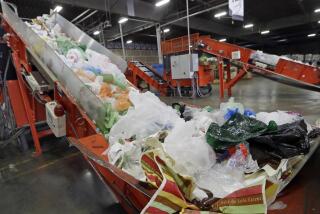U.S. May Have to Trash Throw-Away Attitudes
- Share via
By 1999 you may be paying by the pound to get rid of your garbage. Your home could have more recycling bins than trash cans and your supermarket food will probably come with a little less wrapping.
Solid-waste specialists say that such changes are inevitable because a crunch is coming on the garbage front: Half the nation’s 6,000 dumps will be filled and closed in the ‘90s.
The ride into the “recycling decade” may be bumpy. Buyers for recycled newspaper, glass and plastic are sometimes difficult to find. Breaking the generations-old habit of tossing everything into one garbage bin may prove daunting. New recycling systems need hefty appropriations to get started.
But the specialists also see overwhelming motivations for change:
* The cost of simply throwing things away is rising, as communities ship their trash farther and farther away and new environmental regulations make dump maintenance more expensive.
* People are growing more concerned about cleaning up the planet. A Media General-Associated Press poll earlier this year found that 87% of Americans would back a requirement to separate their trash for recycling.
“Environmental awareness is growing by leaps and bounds,” said Sylvia Lowrance, director of the Environmental Protection Agency’s office of solid waste. “We’re going to see a lot of peer pressure, neighborly pressure on people not to throw away everything.”
In garbage, the future is also the past. Increased recycling of discarded material would represent a return to pre-World War II ways in America, such as no-frills packaging of food products.
“By the end of the decade, I think recycling is going to be part of the cultural fabric of society,” said Bruce Weddle, director of the EPA’s municipal solid waste program. “People will be separating out all bottles, cans, newspapers, plastics, leaves and grass clippings instead of throwing them in one can.”
The transition will not occur overnight, the experts say. But “even with the recalcitrant ones,” Lowrance said, “when it hits their pocketbook, they are going to become recyclers.”
As it is now, many communities go to great lengths to dump their garbage.
Northeast states truck trash hundreds of miles to dumps in the Midwest. West Coast cities ship it by rail to rural landfills because their hometown dumps have closed. Much of the interstate garbage business is in jeopardy, however, because landfills are closing and local residents oppose opening new ones to out-of-state waste.
In addition, new EPA landfill regulations due out in December will accelerate the garbage crunch by shutting down many antiquated dumps, Lowrance said. She said the rules will require that dumps be inspected and equipped with multilayered liners to keep liquids from seeping into the water table. About 80% of the dumps in the United States now do not have liners.
Although all this makes recycling an attractive idea, most garbage specialists say that recycling alone will not solve the crisis.
They foresee a need to keep establishing new dumps, especially large regional ones, and to build new incinerators.
Federal officials say the proportion of garbage that is burned in incinerators could rise by the year 2000 to 25% from 10% now. The United States has 149 incinerators; 227 are expected to be on line in 1992. Incinerators have been opposed as sources of air pollution and because of the problem of disposing of toxic ash.
Former EPA administrator William D. Ruckelshaus, now chief executive of Browning-Ferris Industries, an interstate solid-waste hauler, said the crisis demands an integrated solution of recycling, burying and burning garbage. In a telephone interview, he said that people across the country have thwarted this approach by blocking plans for new dumps and incinerators in their areas.
“The idea that we are out of space is ridiculous. EPA needs to encourage states to adopt integrated energy plans,” he said.
Americans bury about 80% of their waste in dumps, burn about 10% of it and recycle the remainder. The EPA predicts that recycling will jump to 25% by 1992. Some states, such as Massachusetts, have set a 50% recycling goal by the year 2000. That would mean widespread recovery of food and yard wastes, which make up 23% of what is buried in dumps.
In 10 states communities are required by law to establish recycling programs. And New York City recently began phasing in mandatory sorting of trash for recycling.
In Seattle, where the last city dump closed three years ago, residents pay $13.75 a month per garbage can for curbside pickup. In one neighborhood, the city is experimenting with weighing each household’s garbage. Trash collectors enter the weight into a truck-board computer, and the bill is sent later.
Seattle’s recycling is free. Residents separate newspapers, junk mail, aluminum, grass clippings and even old latex paint.
Ginny Stevenson of the city’s recycling program said: “The pocketbook was probably the biggest instigator for people to get involved in recycling.”
As if to herald the “recycling decade” of the 1990s, a magazine on solid-waste management has arrived on the scene just in time. It’s called, simply, Garbage. And it is printed on recycled paper.
BACKGROUND Every two days, Americans generate almost a billion pounds of garbage. The dumps can no longer hold it all. Many communities already ship their trash out of state, a stopgap measure at best. Waste managers say recycling can be no more than part of the solution.
More to Read
Sign up for Essential California
The most important California stories and recommendations in your inbox every morning.
You may occasionally receive promotional content from the Los Angeles Times.













